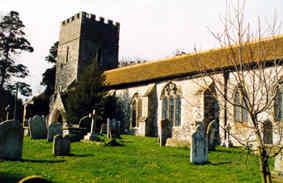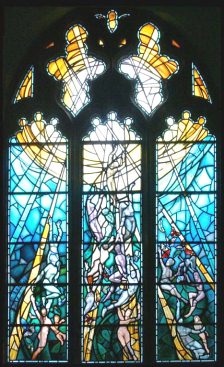History

Staple's Church
St. James The Great� (Page 1)
Video Included by kind permission of Lester Music UK.

Staple Church now has a stunning 21st century designed 3 light stained glass window in the south wall of the Nave.
The Pilgrimage Window, designed by Buffy Tucker and made by her and other craftsmen at the Cathedral Studios at Canterbury Cathedral was installed in November 2007 as a gift to the church by Mrs Burges in memory of her husband Roger Burges who was organist at St James at the time of his death in 2005 and had been involved with the music and choral singing at the church for many years. It was dedicated by the Archdeacon of Canterbury Ven Sheila Watson at a service on 9th December 2007.
St James the Great is the Patron Saint of Pilgrims hence the theme of Pilgrimage, but the artist has chosen to depict the soul�s spiritual journey to heaven � the parallel journey to that of our bodies in pilgrimage, which she felt to be more uplifting imagery than the comparative heaviness of corporeal striving, with the figures conveying spiritual joy as the souls climb towards the light.� The naked souls� journeys are intended to be perceived as weightless flight, or swimming under water; drawn inexorably towards their heavenly goal. However, the sometimes twisting body positions parallel the struggles we face in our own travels through life
Among the souls there are butterflies, symbolising the transience and delicacy of the human condition; a tribute to God the creator.� �While it celebrates the soul�s release and journey to heaven the window also shows the beauty of the natural world around us in this life.
The design also includes a reference to music, an important part of the human expression of devotion. Curling upwards with the souls is music by Edward Elgar from his oratorio �The Dream of Gerontius�; that sung by the angelic choir as Gerontius� soul approaches heaven.
There are also several prisms incorporated in the white part of �heaven�, casting rainbows into the church interior when the sun shines.
In the bottom right hand light, amongst the more struggling figures, are references to medical science with symbols of some chemical elements and the organic molecule amlodipine (Istin). Mr Burges, as a pharmaceutical scientist, was a key figure in the discovery and development of this medication for angina and high blood pressure.
Do call into the church to see this beautiful new addition - particularly at a time when the sun is shining!
Staple's beautiful church is dedicated to St. James The Great, Apostle and Martyr, and patron saint of all travellers and pilgrims.
The church is mainly 14th & 15th Century, with a tower and East window of 13th Century origin.� You will find traces of both Saxon and Norman work in the building.
In the mid 1550's, the Vicar of Staple (and of Adisham) was John Bland.� He was a fervent believer in the Protestant Faith (at the time of a Catholic Queen, Queen Mary).� He was charged with herecy and burned at the stake in Martyr's Field, Canterbury in July 1555.
The Lychgate:� �The Church has a fine lychgate which bears the date 1664. (Although many believe it be some 200 years older).
The Font:
The ornately decorated, octagonal font was specially made for the church somewhere in East Anglia in about 1480.� On one of the panels is the carved figure of St. James.� The other panels show symbols of the four evangelists, alternating with two of angels and one representing the Holy Trinity.
The Tower:
The tower door is flanked by old stone seats, once used as pews by the elderly or infirm. (Who 'went to the wall').� The capitals here are re-used, dating from Norman times.� A Saxon window was discovered in the tower's East wall in 1892, but remained un-blocked until re-discovery in 1959.
The Tower clock:
The clock is one-handed, showing the hours only.� It was given to the church in 1789 by Lady Lynch of Groves.� The clock was second-hand, having been used elsewhere, and was made long before 1789.� Plans to fit an extra hand in 1864 were never carried out.� The clock fell into disrepair before World War II.� After appeals for funds, clock expert Bernars Hawkins and his son restored the clock to working order free of charge.� The clock received a new dial in 1961.� Ken Smith designed and manufactured an electrified winding mechanism for the clock, and this was officially brought into service by the (then) Bishop of Dover, the Rev. Richard Llewelyn in July 1993.
The Bells:
The bell tower houses one of the oldest bells in Kent: (The number three bell, which was made by Richard Hill of London sometime between 1423 and 1440).� Number four bell dates from 1623 and was cast by Joseph Hatch of Ulcombe, whilst numbers one and two are a mere three-hundred and twenty years old, having been made in 1680 by John Hodson of London.
Continued on Next Page ...............


Bus Timetables |� Maps� | Post Codes | The Black Pig� | The Three Tuns� | The Frog & Orange� |� Local Businesses� |� Layham Nurseries� |� Summerfields Nurseries� |� History� |� Staple Church� |� Barnsole Vineyard� |� Staple & Woodnesborough Parishes� |� Virtual Tous� | Old Photos� | Staple's Neighbours� |� Links� |� Nearby Facilities� |� Staple Groups & Organisations� |� Useful Contact Numbers� |� Parish Council |� Latest Council Minutes� |� Pre-School� |� Village Hall� |� Kent Fire & Rescue� |� Sandwich Neighbourhood Forum� |� News & Events� | View Guestbook |� Sign Guestbook� |� View Archived Entries� | View Forum� |� Add to Forum� |� Shatterling Post Codes� |� Shatterling History� |� Shatterling Old Photos� |� Shatterling News & Events� |� Shatterling Virtual Tour� | Site Map� |� Link To Staple Online� |� Neighbourhood Police Officer���